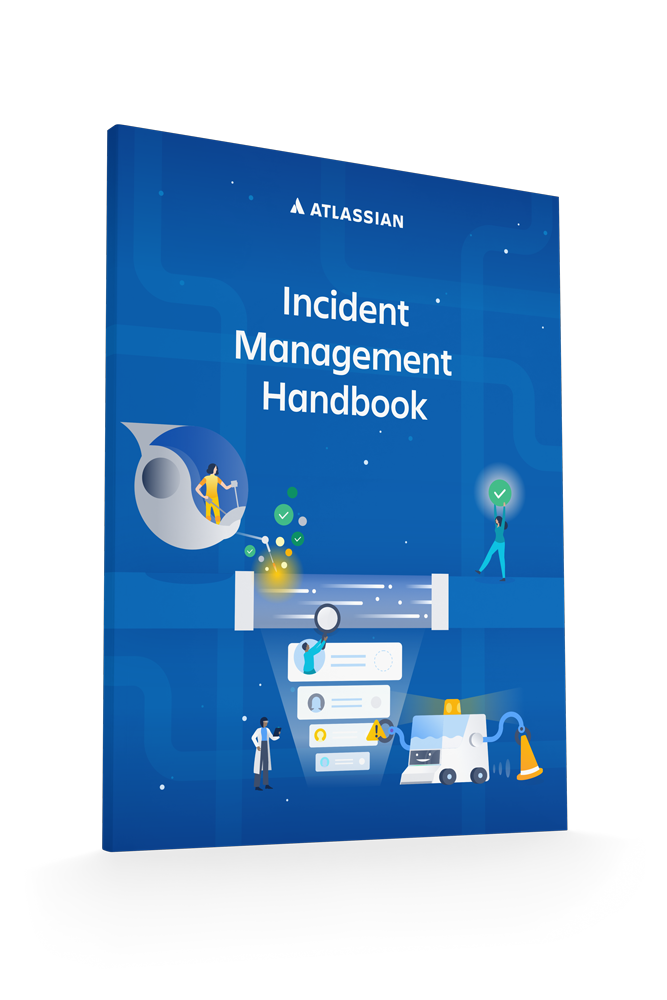Incident management for high-velocity teams
Incident communication templates and examples
Communication templates are one of the most helpful tools during an incident. In the heat of a service outage, the response team is under a lot of pressure and every second counts. Sitting down to a blank page to figure out how to update customers is a lot harder than it seems. We recommend using some boilerplate language to get started.
Be sure to update the placeholder sections before posting. And don’t be afraid to add, edit, or delete pieces of these copy to make them yours.

Get Atlassian's incident management handbook
Learn all the tools and techniques Atlassian uses to manage major incidents.
The incident communication templates we use
Here are the incident communication templates we use at Atlassian, pulled straight from our company Incident Management Handbook. We use separate status pages for internal company staff and external customers.
Public status page
- Incident name: Investigating issues with < product >
- Message: We are investigating issues with < product > and will provide updates here soon.
Internal status page
- Incident name: < Incident issue key > - < Severity > - < Incident summary >
- Message: We are investigating an incident affecting < product x >, < product y > and < product z >. We will provide updates via email and Statuspage shortly.
Example templates for specific incident types
Here are a set of some templates you could utilize during the different stages of an incident:
Investigating a potential outage
Here’s an example incident communications template you can use to announce you’re investigating a potential outage, but haven’t confirmed the impact or scope.
- Incident name: Investigating issues with < product >
- Message: We’re currently investigating reports of a potential service interruption with < impacted services >. We apologize for any inconvenience and will post another update as soon as we learn more.
Full outage
Here’s an example incident communications template you can use during a complete outage.
- Incident name: < Product > service outage
- Message: We’re experiencing a service outage with < impacted services >. Our team is currently working to restore the service. We apologize for any inconvenience. < General impact > users may be affected. Next update in < time until next update >.
Partial outage
Here’s an example incident communications template you can use during a partial outage.
- Incident name: < Product > partial outage
- Message: We’re currently experiencing degraded performance issues with < impacted services >. Our team is currently working to restore normal performance levels. We apologize for any inconvenience. < General impact > users may be affected. Next update in < time until next update >.
Scheduled maintenance
Here’s an example incident communications template you can use during a scheduled maintenance window.
- Scheduled maintenance: We will be performing scheduled maintenance on < service name > on < Date, start time-end time. > During this time, users can expect < expected impact. >
Go deeper: Resources, plans, and tutorials
Templates and samples are helpful, but they’re only a small part of the bigger picture. The best incident response teams build and refine a plan. Here are some more resources to help you build plans incident communication:
- Our Incident Communication Template Generator can help you quickly draft updates during an incident.
- How to create an incident response playbook
- Get your sheet together: how to create an incident communication plan
- Download our incident communication plan template
- Getting Started with an Incident Communications Plan
- Top 5 incident communication tips
Want to learn how to build and save your own incident templates? Try our interactive incident communications tutorial.
Learn incident communication with Statuspage
In this tutorial, we’ll show you how to use incident templates to communicate effectively during outages. Adaptable to many types of service interruption.
Read this tutorialIncident Response: Best Practices for Quick Resolution
Discover key incident response techniques to quickly address and resolve critical issues in your organization.
Read this article